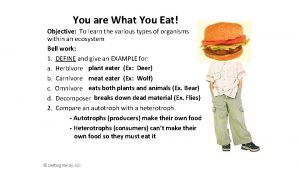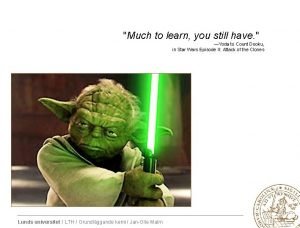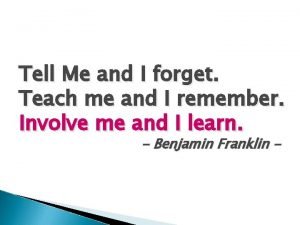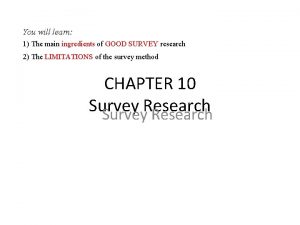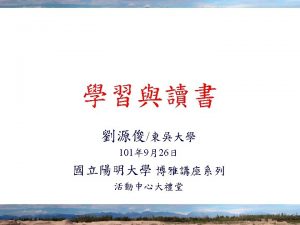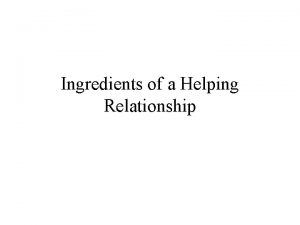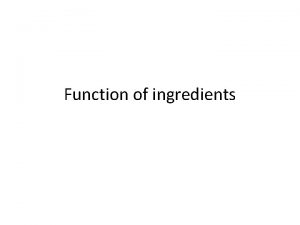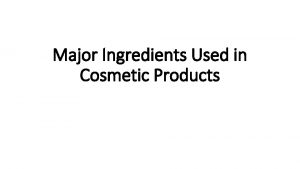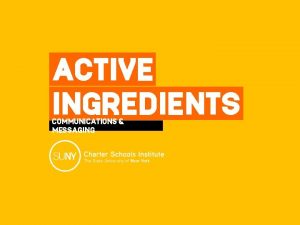You will learn 1 The main ingredients of













- Slides: 13

You will learn: 1) The main ingredients of GOOD SURVEY research 2) The LIMITATIONS of the survey method CHAPTER 10 Survey Research

Introduction • The survey is the most widely used data-gathering technique in sociology, and it is used in many other fields as well • It’s easy to conduct a survey that yields misleading or worthless results • Good surveys require thought and effort • Surveys can be well made or poorly made and can be used in appropriate or in appropriate ways

Research Questions Appropriate for a Surveys produce: 1) Quantitative information about the social world 2) Describe features of people/social world üSurvey used to explain and explore üSurveys are appropriate for research questions about selfreported (beliefs/behaviors) üSurveys are strongest when the answers people give to question measure variable üSurveys have many variables (often with multiple indicators) and test several hypotheses

The following can be asked in a survey Overlapping categories Behavior Attitudes/beliefs/opinions Characteristics Expectations Self-classification Knowledge




A History of Survey Research üThe modern survey can be traced back to old forms of the census üA census includes information on characteristics of the entire population üIt’s based on what people tell officials or what officials observe üEarly census assessed the property available for taxation and military service üLater, officials used the census to assign the number of elected representatives üThe survey used for social research in USA and UK began with social service professions documenting the conditions of urban poverty üAt first, survey were overviews of an area based on questionnaires and other data. Scientific sampling and statistics were absent üSocial survey grew into: modern quantitative survey research and qualitative field researcher in a community

üFour forces greatly reshaped the social survey into modern quantitative survey research in USA 1) Researcher applied statistically based sampling techniques and precise measurement to the survey 2) Researcher created scales and indexes to gather systematic quantitative data on attitudes, opinions, and subjective aspects of social life 3) Others found uses for the survey and adapted it to a variety of applied areas (e. g. , marketing, Journalists, Religious, Government agencies, Social scientists üThere was a major reorientation of most empirical social research, which created respectable “scientific” methods modeled after the natural sciences üSocial research became more professional, objective, and nonpolitical üThis orientation was stimulated by 1) A competition among researcher and universities for status, prestige and funds 2) Researchers turning away from social reform ideals after the end of Progressive era 3) A program of major private foundations to fund the expansion of quantitative, positivist social research

The Logic of survey research What’s a Survey? Survey researchers measure variables that represent alternative explanations (i. e. , control variables) They think in of alternative explanations when planning a survey and measure the alternatives with control variables Survey research is often called correlational. Survey researchers use control variables and correlations in statistical analysis. They approximate the rigorous test for causality that experimental achieve with their physical control over temporal order and alternative explanations.

Example A group of people is randomly divided into an experimental and a control group (alternative explanations). The control group is given an aptitude test after having eaten a full breakfast. The experimental group is given the same test without having eaten any breakfast. Experimental unit = person Response = Score on test Factor = meal Levels = Breakfast or no breakfast Treatments: Breakfast or no breakfast

Example Is the attention span of children affected by whether or not they had a good breakfast? Twelve children were randomly divided into three groups and assigned to a different meal plan. The response was attention span in minutes during the morning reading time. No Breakfast Light Breakfast Full Breakfast 8 14 10 7 16 12 9 12 16 13 17 15 k = 3 treatments. Are the average attention spans different?

Steps in Conducting a Survey? The survey researchers follows a deductive approach. He or she a) Begins with a theoretical (or applied) research problem b) Ends with empirical measurement and data analysis
 7 basic baking ingredients
7 basic baking ingredients Describe the chemistry and main ingredients of uv gels
Describe the chemistry and main ingredients of uv gels Kinesthetic learners learn best by
Kinesthetic learners learn best by The more you study the more you learn
The more you study the more you learn Man lernt solange man lebt
Man lernt solange man lebt Getting nerdy llc
Getting nerdy llc Medelatommassa
Medelatommassa Extension work activities
Extension work activities Describe the ant by filling this character trait web
Describe the ant by filling this character trait web You obey your teachers
You obey your teachers Would you rather learn english or french passive voice
Would you rather learn english or french passive voice Tell me i forget
Tell me i forget What do you expect to learn
What do you expect to learn Chips countable or uncountable
Chips countable or uncountable





